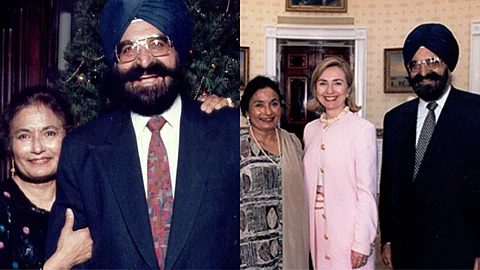
- HOMEGROWN WORLD
- #HGCREATORS
- #HGEXPLORE
- #HGVOICES
- #HGSHOP
- CAREERS
- ABOUT US
- CONTACT US

If you're reading this, it's most likely due to fibre optics which is a system of telecommunication our internet and wifi depends on. Fiber optics transmit data in the form of light particles or photons that pulse through a cable as thin as a hair-strand, with a glass core and cladding. These light signals refract and travel great distances carrying large amounts of data. And that's how we get to stream our favourite music and movies.
Talking about how important the internet has become a part of our lives and embedded itself into the cultural zeitgeist is redundant so we won't. Rather, let's remember the man who made this all possible, the man who bent light and changed communication forever, Dr. Narinder S. Kapany.
Born in Moga, Punjab in 1926 Dr. Kapany was a curious kid playing around with box cameras fascinated by the characteristics of light. He went to school in Dehradun and famously asked his teacher how to bend light and got a snarky answer that you cannot.
“No, that doesn’t sound right,” he thought to himself, accepted the challenge and started his journey to prove his teacher wrong.
By the time he entered graduate school at Imperial College London in 1952, he realized that he wasn’t alone in this pursuit. Researchers across Europe had been studying ways to transmit light through flexible glass fibres for decades. But a series of obstacles, the World War II being one of them, had set them back. One researcher was a scientist called Harold Hopkins who hired Kapany as research assistant.
Dr. Kapany worked tirelessly to assemble a coherent bundle of hundreds of glass fibres to build a flexible fibrescope for transmitting images that was described in a paper published with Hopkins in Nature in 1954. The work was simultaneously published alongside another research paper on fibre-based light transmission, and the two papers marked the birth of fiber optics.
Not only did Dr. Kapany coin the term 'fibre optics' in an article in Scientific American, but he also came to be known as 'The Father of Fibre Optics'.
After obtaining his doctorate in 1955, Dr. Kapany authored & co-authored over 150 scientific papers. The explosion of research related to fibre optics led Kapany to publish the book Optical Fibres - Principles and applications in 1967 that became a world reference in the field of optics. He wrote 3 other books during his lifetime and his seminal research in fibre optics, lasers, and solar energy, and their applications in bio-medical instruments, defense, communications, and pollution-monitoring earned him more than 100 patents.
Many scientists in the community including Indian physicist, Shivanand Kanavi believed that Kapany was robbed of a Nobel Peace Prize for his contributions. While Chinese scientist Charles K Kao was one of the recipients of the Nobel Prize for Physics in 2009 for groundbreaking achievements concerning the transmission of light in fibres for optical communication, it was Dr. Kapany who first demonstrated successfully that light can be transmitted through bent glass fibres.
However, his interests weren't limited to physics. Dr. Kapany was proud of his origins championing Sikh culture and language. He created the Sikh Foundation in 1967 which pioneered the display of Sikh arts at the Victoria and Albert Museum in London, the Smithsonian Museum in Washington, DC, and at the Rubin Museum in New York. He and his wife, Satinder, were both avid art collectors. They scoured the globe for all things Sikh, making their home in Woodside a virtual museum.
As an art enthusiast, Dr. Kapany himself became an artist, creating ‘dynoptic’ sculptures in the late 1960s. One of his employees had an accident and ended up bending the glass rod while using the fibre drawing machine. He threw it in the trash and when Dr. Kapany saw the bent glass rod, he thought to himself, “My god, this is art. So I took it home and ended up adding several other pieces to it.” He went on to create 50 dynoptic sculptures and was approached by Frank Oppenheimer (American physicist, professor and founder of Exploratorium), who obtained Kapany’s permission to display his art project at the Exploratorium, museum of science, life and human perception, in San Francisco in 1972.
Dr. Kapany spent his last years writing his memoir The Man Who Bent Light and died in his home in Woodside, California at the age of 94. He was awarded the Padma Vibhushan award posthumously.
Narinder S. Kapany was a trailblzer in the science community. He led a marvellous life making groundbreaking inventions and discoveries that laid a foundation for essential technological development in the future. And he shared the same passion for art, engaging curators at prestigious museums around the globe in conversations about the significance of Sikh art and collecting Sikh material heritage like art, numismatics, manuscripts, rare books, textiles, and weaponry. A beacon of light himself, Dr. Kapany had a giant, shining spirit grounded to this roots and soaring the heights of discovery and invention. He is truly one of India's greatest heroes.
